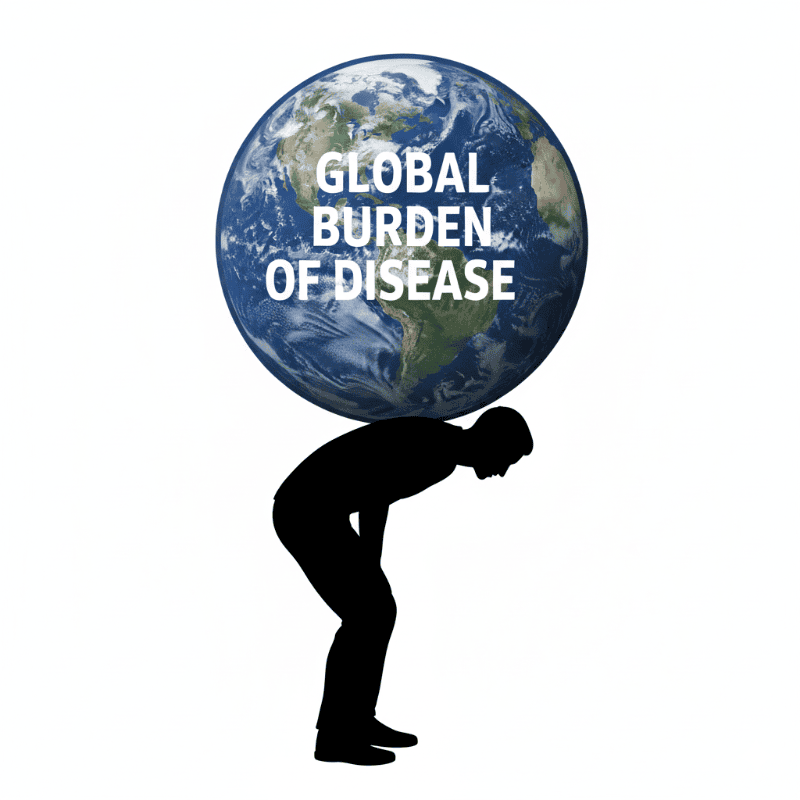Global mortality rates fall sharply, but youth deaths surge in stark health divide
A comprehensive analysis of 204 countries reveals life expectancy gains of more than 20 years since 1950, yet adolescents and young adults face rising mortality in North America, Latin America, and sub-Saharan Africa. Non-communicable diseases now account for nearly two-thirds of global health burden.

The world stands at a critical juncture in public health, with mortality rates declining globally whilst deaths among young people escalate in specific regions, according to the latest Global Burden of Disease (GBD) study published in The Lancet on 12 October 2025. The comprehensive research, spanning 204 countries and territories from 1950 to 2023, reveals profound shifts in disease patterns and widening health inequities that demand urgent policy intervention.
Mortality declines mask emerging youth crisis
The study documents remarkable progress in global health outcomes, with the age-standardised mortality rate declining by 67% since 1950. Global life expectancy reached 76.3 years for females and 71.5 years for males in 2023, representing gains of more than 20 years compared to 1950 levels. Despite population growth and ageing, all 204 countries and territories recorded mortality declines over the study period.
However, these achievements conceal a disturbing trend amongst adolescents and young adults. “The rapid growth in the world’s aging population and evolving risk factors have ushered in a new era of global health challenges,” said Dr Christopher Murray, Director of the Institute for Health Metrics and Evaluation (IHME) at the University of Washington School of Medicine. “The evidence presented in the Global Burden of Disease study is a wake-up call, urging government and health care leaders to respond swiftly and strategically to the disturbing trends that are reshaping public health needs.”
The largest increase in deaths occurred among those aged 20 to 39 in high-income North America from 2011 to 2023, driven primarily by suicide, drug overdose, and high quantities of alcohol. During the same period, deaths in the 5–19-year age group increased in Eastern Europe, high-income North America, and the Caribbean. This represents a reversal of decades-long progress in reducing mortality across all age groups.
Profound geographic disparities persist
Whilst global life expectancy returned to pre-pandemic levels, stark geographic differences remain. Life expectancy ranges from 83 years in high-income regions to merely 62 years in sub-Saharan Africa. The global mean age at death increased from 46.4 years in 1990 to 62.9 years in 2023, yet regional inequities remain profound. In the high-income super-region, females reached a mean age of death of 80.5 years and males 74.4 years, compared to 37.1 years for females and 34.8 years for males in sub-Saharan Africa.
Advanced modelling techniques employed in the GBD 2023 study revealed that mortality in children aged 5–14 in sub-Saharan Africa from 1950 to 2021 was higher than previously estimated, driven by elevated rates of respiratory infections, tuberculosis, other infectious diseases, and unintentional injuries. New calculations also showed mortality in young adult females aged 15–29 in sub-Saharan Africa was 61% higher than previously estimated, predominantly due to maternal mortality, road injuries, and meningitis.
Non-communicable diseases dominate global health burden
The research documents a fundamental shift in global disease patterns, with non-communicable diseases (NCDs) now accounting for nearly two-thirds of total mortality and morbidity worldwide. After standing as the leading cause of death in 2021, COVID-19 declined to 20th place in 2023, returning ischaemic heart disease and stroke to the top positions, followed by chronic obstructive pulmonary disease, lower respiratory infections, and neonatal disorders.
The three capstone papers – covering demographic analysis, causes of death, and burden of diseases, injuries, and risk factors – provide unprecedented detail on global health trends. The studies analysed data for 375 diseases and injuries and 88 risk factors by age and sex globally, regionally, and nationally for 204 countries and territories and 660 subnational locations from 1990 to 2023.
Whilst mortality rates for ischaemic heart disease, stroke, diarrhoeal diseases, tuberculosis, stomach cancer, and measles have declined since 1990, death rates increased during the same period for diabetes, chronic kidney disease, Alzheimer’s disease, and HIV/AIDS. The probability of dying before age 70 decreased across each GBD super-region and region from 2000 to 2023, except for drug use disorders, which emerged as a leading cause of premature mortality.
Half of disease burden attributable to modifiable risks
Nearly half of global mortality and morbidity in 2023 was attributable to 88 modifiable risk factors, offering substantial opportunities for prevention. The ten risk factors with the highest proportion of health loss were high systolic blood pressure, particulate matter pollution, smoking, high fasting plasma glucose, low birthweight and short gestation, high body mass index (BMI), high LDL cholesterol, kidney dysfunction, child growth failure, and lead exposure.
From 1990 to 2023, the age-standardised rate of disability-adjusted life years (DALYs) – measuring total years of healthy life lost through premature death and years lived with disability – fell by 36%. From 2010 to 2023, DALY rates for communicable, maternal, neonatal, and nutritional (CMNN) diseases fell by almost 26%, led by diarrhoeal disease rates being cut in half, a 43% decrease in HIV/AIDS rates, and a 42% drop for tuberculosis.
However, concerning increases emerged in several risk factors. Between 2010 and 2023, DALY rates for high BMI rose by almost 11%, drug use by nearly 9%, and high blood sugar by 6%. New modelling methods for lead exposure revealed a direct link to cardiovascular diseases. Although removing lead from fuel has contributed to substantial declines in exposure, it remains a common environmental contaminant found in paint in older buildings, contaminated soil, water, spices, and many cooking utensils.
Climate-sensitive risks intensify health threats
Climate-sensitive risks, including air pollution and heat, continue to exert significant impacts on global health. DALY rates for particulate matter pollution – the second-leading risk factor – were highest at the super-region level in South Asia, sub-Saharan Africa, and North Africa and the Middle East. High temperatures are exacerbating vulnerabilities in these regions, particularly the Sahel, by compounding the effects of drought, food insecurity, and displacement.
Risk factors varied substantially by age group. Among children under five, the leading risk factors were child and maternal malnutrition, particulate matter pollution, and unsafe water, sanitation, and hygiene (WaSH). For children and adolescents aged 5 to 14 years, iron deficiency was the leading risk, followed by others related to unsafe WaSH and child and maternal malnutrition. For the 15 to 49 age group, the top two risks were unsafe sex and occupational injuries, followed by high BMI, high systolic blood pressure, and smoking.
Mental health burden escalates globally
The burden of mental disorders continued to surge globally, with anxiety disorders increasing death and disability by 63% and depressive disorders by 26%. Sexual abuse and intimate partner violence were identified as preventable contributors to depression, anxiety, and other health consequences, highlighting the need for comprehensive interventions addressing both mental health conditions and their social determinants.
From 2010 to 2023, injury-related DALY rates decreased by 16%, though the burden remained substantially higher in males, particularly amongst older children and young adults aged 10 to 24, accounting for more than double the total DALYs compared to females.
Resource constraints threaten progress
The study employed over 310,000 total data sources for the latest iteration, 30% of them new to this year’s analysis. It included 1,211 location-years of provisional all-age vital registration data not previously used, providing more timely information. Dr Murray’s team at IHME and its GBD Collaborator Network of 16,500 scientists and researchers collected and analysed data to produce the most comprehensive research quantifying health loss globally.
“Decades of work to close the gap in low-income regions with persistent health inequities are in danger of unravelling due to the recent cuts to international aid,” said Emmanuela Gakidou, senior author and professor at IHME. “These countries rely on global health funding for life-saving primary care, medicine, and vaccines. Without it, the gap is sure to widen.”
The research underscores the urgent need for policymakers to expand health priorities beyond reducing child mortality to include adolescents and young adults, particularly in areas with higher mortality rates than previously known. Low-income regions experiencing sharp rises in NCDs face additional constraints with limited resources, whilst cuts to international aid threaten to reverse decades of progress in closing health equity gaps.
References
- GBD 2023 Demographics Collaborators. (2025). Global age-sex-specific all-cause mortality and life expectancy estimates for 204 countries and territories and 660 subnational locations, 1950–2023: A demographic analysis for the Global Burden of Disease Study 2023. The Lancet. https://www.thelancet.com/journals/lancet/article/PIIS0140-6736(25)01330-3/fulltext
- GBD 2023 Causes of Death Collaborators. (2025). Global burden of 292 causes of death in 204 countries and territories and 660 subnational locations, 1990–2023: A systematic analysis for the Global Burden of Disease Study 2023. The Lancet. https://www.thelancet.com/journals/lancet/article/PIIS0140-6736(25)01917-8/fulltext
- GBD 2023 Diseases and Injuries Collaborators. (2025). Burden of 375 diseases and injuries, risk-attributable burden of 88 risk factors, and healthy life expectancy in 204 countries and territories, including 660 subnational locations, 1990–2023: A systematic analysis for the Global Burden of Disease Study 2023. The Lancet. https://www.thelancet.com/journals/lancet/article/PIIS0140-6736(25)01637-X/fulltext

